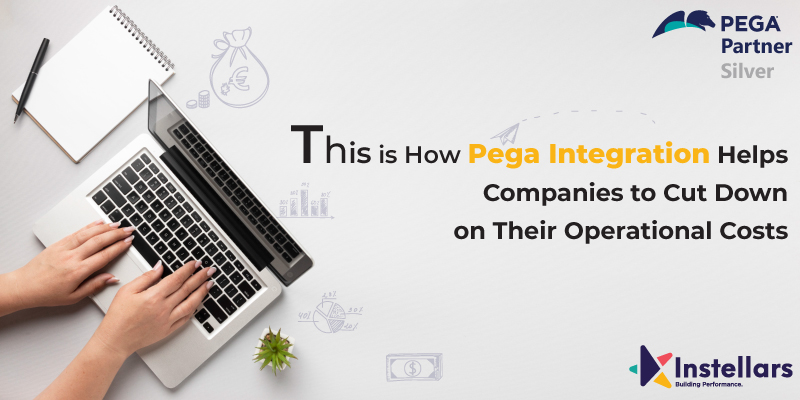
This is How Pega Integration Helps Companies to Cut Down on Their Operational Costs

Pegasystems Inc. is a software development firm based out of Massachusetts, the United States of America (USA). The company is known for its software solutions to efficiently manage business process management (BPM), digital process automation, and customer relationship management (CRM).
These tools of Pega are among the most sought after software in the market, especially since the COVID-19 pandemic changed the way the companies went about their business and operations. The ongoing pandemic called for businesses to optimise their cost and come up with innovative methods to cater to customer needs.
Business process management tools have become a luring option among all sectors these days. Even the well-established investment and banking firms and government agencies are turning towards business process management tools to reduce their cost of operation and increase output.
Every organisation looks to get the best return on their investment and that is exactly what one would get with a good business management process tool. The rate of return is worth the investment and it optimises your overall operational cost. It would also help in decreasing the application delivery time.
The reason why integrating your business with Pega is a good option is that it is a no or low-code system with a tool built on agile development. This helps in significantly decreasing time-to-delivery and reducing the maintenance cost of the system. The tool also has the ability to coach the employees to maintain and develop applications.
The integrated system combines the enterprise platform with the tools and results in a reduced cost of operation. If the tools and platforms are to be managed separately, then the cost of maintenance and operation increases. Pega integration provides another feature in which it streamlines the cost and process of licensing and hosting.
Pega Integration Facilitates Agile Development for Increased Delivery
Pega's BPM is built on a minimal code tool focused on the agile scrum methodology. Even though it has become popular these days to adopt agile function for developing systems, the approach can be useful in system maintenance as well.
The Pega BPM solution stitches the guidelines and models together with agile principles. It increases choices and reduces the delivery time for system modifications.
Pega is a solitary platform that has components built on the model-driven approach, a database arrangement for every hosted system, tools for requirement building, and an operating system that binds the organisation together.
Every change to be made in the platform, which falls under the activities of adaptive and preventive maintenance, is a part of the business process management upgrade. The relevant teams must look into the resulting changes for all components that are integrated with the system.
Minimal Coding - A No/Low Code Platform
The integration with the Pega platform has simplified the manipulation of the application code and database designing and implementing as hardly any staff is required to come from the software background. This is because the entire platform is built with no or minimal coding. The other similar tools require a team of specialists to handle the integrated system, and this is where Pega’s BPM scores better.
Any corrective maintenance requires a reverse-engineering approach regardless of the platform on which the system is built on. However, if the select feature or tool is integrated with a reliable and modern platform, the cost of maintenance will become more affordable and predictable at the same time.
The implementation of coding is optimised to a greater extent with Pega’s no/low code platform. The Dev Studio and development tools that come with Pega are efficient, comprehensive, and inherent to use. The Pega’s platform provides training to the relevant employees of the organisation and hence it helps anybody become competent in using and running the platform.
Reactive Maintenance Support
Apart from keeping the actual application code updated as a process relevant to maintenance, the related team of individuals in the organisation must authenticate the possible reverberations on the user interface. The UX of Pega is designed for multiple channels and is responsive. It is built on a standard UI model which brings down the cost of design.
The in-built process of the Pega’s platform is structured in a way that when something is designed, it could be deployed for production everywhere. The relevant tools are automatically updated on the customer’s device as per their specifications.
This reduces the time needed to test if the production of the update across all device types is working or not. This leaves more time with the team to concentrate on other areas and hence, cuts down the overall time and cost required to roll out updates across all channels.
Reengineering of the System
Pega’s platform has been designed in such a way that you can create a process which can be easily modified to meet the requirements of all possible situations. This drastically reduces the time and cost of reengineering and maintenance. Pega ably produces reusable, differentiated and iterative solutions by understanding policies and processes that are generic. These can then be tailored to cater to the specific needs of an organisation.
Workflow Management
The BPM tool is designed in such a way that it helps an organisation automate its entire work across all channels. The adaptive decision management trait of the Pega’s system enables businesses to make use of big data and other similar technologies to improve and reduce the time required to make decisions. The system adapts to and improves on a real-time basis to go beyond and retrieve the required data in minimal time.
The case lifecycle management traits that are built-in on the platform will help in organising the stages, objectives and steps rather than lengthy processes and transactions, which enables better understanding and cognizance among the leaders and stakeholder. This leads to a quicker recognition of the changes needed and delivery of the same.
Conclusion
The Pega BPM platform is designed to help organisations reduce their delivery time, cost and implement an agile-based approach for automating processes, capturing requirements, and system maintenance.
The transformation that matters
Send your resume to Careers @ Instellars
